#cepheid variable stars
Explore tagged Tumblr posts
Text
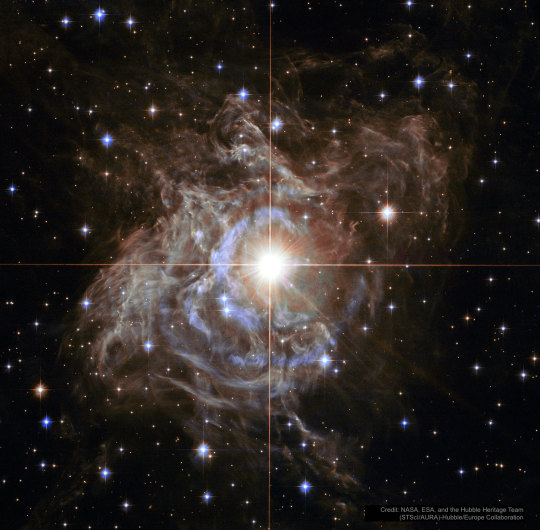
A Cepheid variable © Hubble
#stars#space#astrophotography#cepheid variable stars#planet#solar system#galaxy#universe#cosmos#astronomy#nasa#night sky
1K notes
·
View notes
Text
❣️💛❤️

Some stars pulse, becoming brighter and and dimmer. A certain type, known as Cepheid variable stars, brighten and dim on regular schedules. This spiral galaxy, NGC 5584, contains over 600 of them. They’re useful for studying great distances in space. Credit: Hubble/NASA, ESA.
#nasa#astronomy#space#hubble#gods creation#universe#beauty#NGC 5584#Cepheid variable stars#hubble space telescope#galaxy#hubble telescope#cephid variables
169 notes
·
View notes
Text
0 notes
Link
Embark on a cosmic odyssey with Andrew Dunkley and Professor Fred Watson as they unravel the mysteries of the universe's expansion and unearth a colossal Martian secret in this episode of Space Nuts. Dive into the perplexing debate over the universe's expansion rate, as new findings from the James Webb Space Telescope reignite the Hubble tension. With precision cosmology at our fingertips, discover why the universe's growth spurs more questions than answers, leaving us to ponder the potential for undiscovered physics that could reshape our cosmic understanding. Then, join the expedition to Mars where a hidden giant lay dormant until now. The discovery of a monstrous volcano, nestled in the labyrinthine Noctis Labyrinthus, has scientists buzzing with excitement. Towering over 9,000 meters with a footprint spanning 450 kilometers, this Martian marvel could hold vital clues to the planet's fiery past and icy secrets beneath its surface. As explorers eye this volcanic behemoth as a future landing site, the prospects of unlocking Mars' ancient mysteries have never been more alluring. From the enigmatic expansion of the cosmos to the volcanic vistas of Mars, this episode is a treasure trove for space enthusiasts and cosmic detectives. Tune in and let your imagination soar to new interstellar heights with Space Nuts. Remember to subscribe and follow us for more celestial tales and astronomical adventures. Until our next galactic gathering, keep your eyes to the skies and your heart in the stars. 🚀 Episode Chapters (00:00) Andrew Dunkley introduces the cosmic conundrums (05:12) The Hubble tension and the universe's expansion speed (11:34) Professor Fred Watson discusses the James Webb Space Telescope's findings (18:20) Unveiling the newly discovered Martian volcano (24:45) The potential of Mars' glacial ice and future explorations (28:57) Wrapping up with a look ahead to Space Nuts Q&A This episode is brought to you by NordPass - the best way to manage all your passwords and lose that angst for not very much money. Like... seriously cheap... check out the special discount deal at www.bitesz.com/nordpass
#acoustic#background#baryonic#cepheid#constant#cosmic#expansion#hubble#ia#james#microwave#space#speed#stars#supernovae#telescope#type#universe#variable#webb
0 notes
Text
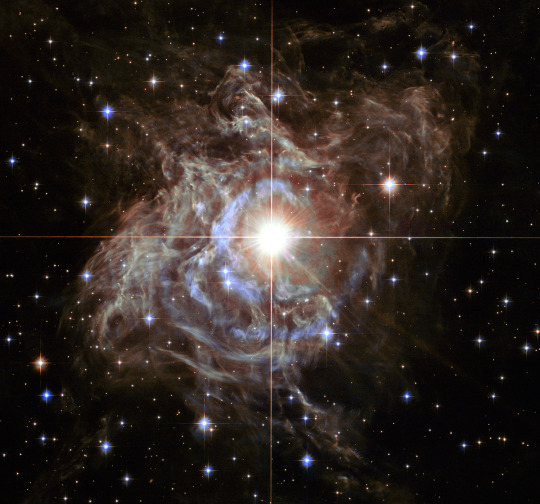
RS Puppis, Cepheid Variable Star
#stars#outer space#space#cosmic#cosmos#astral#astro#gold#universe#galaxies#space dust#cepheid star#beautiful#beauty#escape#pretty#spiritual#dark#astrophotography#photography#nasa#hubble
448 notes
·
View notes
Text
Cepheid variables have a period that is directly related to their absolute luminosity. So they make a percent t yardstick to measure intergalactic distances.
The day Hubble discovered the Universe.
101 years ago Today, Edwin Hubble took a picture of this Cepheid variable in M31 or the Andromed galaxy.
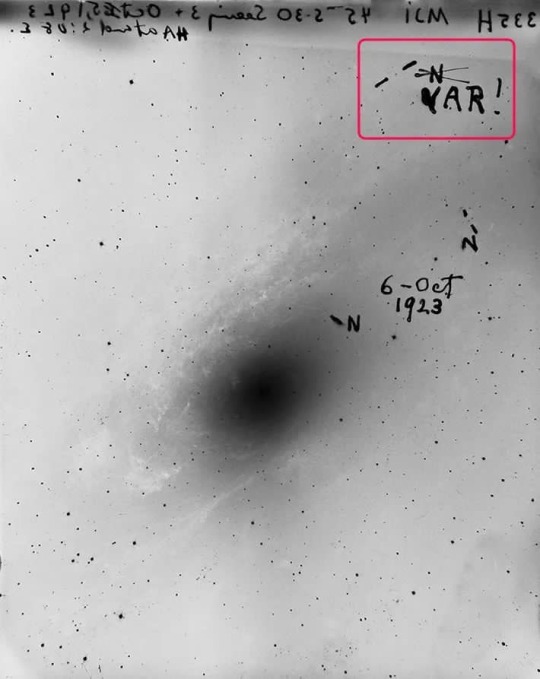
52 notes
·
View notes
Photo
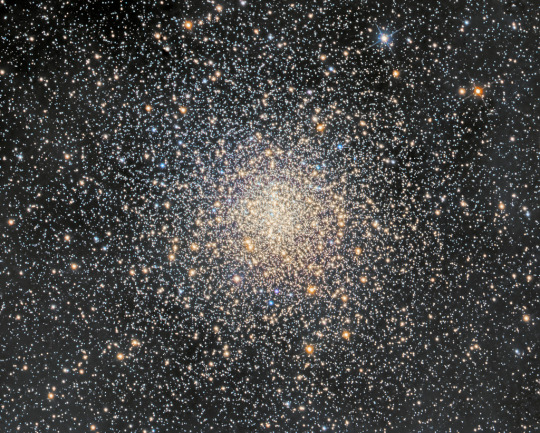
2024 November 29
Messier 4 Image Credit & Copyright: Steve Crouch
Explanation: Messier 4 can be found west of bright red-giant star Antares, alpha star of the constellation Scorpius. M4 itself is only just visible from dark sky locations, even though the globular cluster of 100,000 stars or so is a mere 5,500 light-years away. Still, its proximity to prying telescopic eyes makes it a prime target for astronomical explorations. Recent studies have included Hubble observations of M4's pulsating cepheid variable stars, cooling white dwarf stars, and ancient, pulsar orbiting exoplanet PSR B1620-26 b. This sharp image was captured with a small telescope on planet Earth. At M4's estimated distance it spans about 50 light-years across the core of the globular star cluster.
∞ Source: apod.nasa.gov/apod/ap241129.html
146 notes
·
View notes
Text
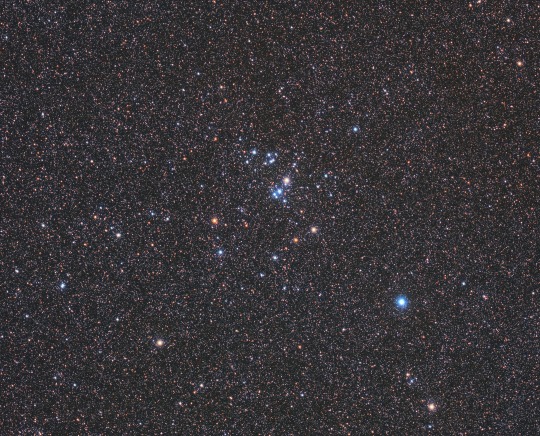
The S Normae Cluster, C89 // Fernando Oliveira de Menezes
This open cluster is named after the brightest of its member stars, S Normae, a white-yellow giant star about 6 times more massive and 65 times larger than the Sun.
Importantly for astronomers, S Normae is a class of star called a Cepheid variable. These stars change their brightness at a regular and predictable rate. There is also a relationship between a Cepheid's pulsation rate and its intrinsic brightness, a fact discovered by Henrietta Swan Leavitt (1868-1921). That means that a Cepheid's pulsation rate tells us how truly bright it is, so how bright it appear to us tells us how far away it is! This makes Cepheids important standard candles for measuring distances in the universe.
#astronomy#astrophotography#caldwell catalog#stars#star cluster#open cluster#S Normae Cluster#NGC 6087#caldwell 89#C89#star#S Normae#norma
22 notes
·
View notes
Text

A century ago, our understanding of the universe exploded ❣️💛❤️
By observing a Cepheid variable star (which pulse at a rhythm directly tied to their luminosity) called V1, astronomer Edwin Hubble determined that our galaxy wasn't the whole universe.
Our universe, rather, is full of countless galaxies beyond our own Milky Way.
His observations of V1, nestled inside the Andromeda "nebula", confirmed that Andromeda is actually an entire galaxy itself, located over two million light-years away. That distance far exceeded anything in our own Milky Way, and led Hubble to the jaw-dropping realization that the universe extends far, far beyond our galaxy.
Edwin Hubble went on to measure the distances to many galaxies beyond the Milky Way. The velocities of those galaxies also allowed him to determine that the universe is expanding.
In the hundred years since, the telescope named for Edwin Hubble continues his legacy, measuring and observing our massive, expanding universe.
Read more about this benchmark discovery and anniversary: https://go.nasa.gov/4h7erxq ❣️💛❤️ Image credit: NASA, ESA, Hubble Heritage Team (STScI/AURA); Acknowledgment: R. Gendler
12 notes
·
View notes
Text
The “Aha!” photo
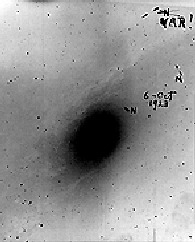
Andromeda Nebula: Var! - April 6th, 1996.
"In the 1920s, using photographic plates made with the Mt. Wilson Observatory's 100 inch telescope, Edwin Hubble determined the distance to the Andromeda Nebula - decisively demonstrating the existence of other galaxies far beyond the Milky Way. His notations are evident on the plate shown above (the image is a negative with stars appearing as black dots against the white background of space). By intercomparing plates, Hubble searched for "novae", stars which underwent a sudden increase in brightness. He found several on this plate and marked them with an "N". Later he discovered that one was actually a type of variable star known as a cepheid - crossing out the "N" he wrote "Var!" (upper right). Thanks to the work of Harvard astronomer Henrietta Leavitt, cepheids, regularly varying, pulsating stars, could be used as "standard candle" distance indicators. Identifying such a star allowed Hubble to show that Andromeda was not a small cluster of stars and gas within our own galaxy, but a large galaxy in its own right at a substantial distance from the Milky Way. Hubble's discovery is responsible for our modern concept of a Universe filled with galaxies."
17 notes
·
View notes
Text
Not a lot of people pay attention to this, but most Nanook's/Destruction's blessings in the Simulated Universe are Astronomy related!!
Let's start from the 1 star blessings (not gonna add images because the MAX is 10 images lmao):
Eternally Collapsing Object
(This blessing could be a reference to) The magnetospheric eternally collapsing object (MECO) is an alternative model for black holes initially proposed by Indian scientist Abhas Mitra in 1998 and later generalized by American researchers Darryl J. Leiter and Stanley L. Robertson. A proposed observable difference between MECOs and black holes is that a MECO can produce its own intrinsic magnetic field. An uncharged black hole cannot produce its own magnetic field, though its accretion disk can.
Instability Strip
The unqualified term instability strip usually refers to a region of the Hertzsprung–Russell diagram largely occupied by several related classes of pulsating variable stars: Delta Scuti variables, SX Phoenicis variables, and rapidly oscillating Ap stars (roAps) near the main sequence; RR Lyrae variables where it intersects the horizontal branch; and the Cepheid variables where it crosses the supergiants.
Orbital Redshift
(This blessing could be a reference to) The main causes of electromagnetic redshift in astronomy and cosmology are the relative motions of radiation sources, which give rise to the relativistic Doppler effect, and gravitational potentials, which gravitationally redshift escaping radiation. All sufficiently distant light sources show cosmological redshift corresponding to recession speeds proportional to their distances from Earth, a fact known as Hubble's law that implies the universe is expanding.
Primordial Black Hole
In cosmology, primordial black holes (PBHs) are hypothetical black holes that formed soon after the Big Bang. In the inflationary era and early radiation-dominated universe, extremely dense pockets of subatomic matter may have been tightly packed to the point of gravitational collapse, creating primordial black holes without the supernova compression typically needed to make black holes today. Because the creation of primordial black holes would pre-date the first stars, they are not limited to the narrow mass range of stellar black holes.
(I'm gonna skip the two star blessings because I don't think there's any Astronomy related ones?)
Universal Heat Death Characteristic
The heat death of the universe (also known as the Big Chill or Big Freeze) is a hypothesis on the ultimate fate of the universe, which suggests the universe will evolve to a state of no thermodynamic free energy, and will therefore be unable to sustain processes that increase entropy. Heat death does not imply any particular absolute temperature; it only requires that temperature differences or other processes may no longer be exploited to perform work. In the language of physics, this is when the universe reaches thermodynamic equilibrium.
Non-Inverse Antimatter Equation
E=mc2
The story of antimatter begins (again) with Einstein and his famous formula: E=mc2. It means that energy and mass are interchangeable - so mass can be transformed to energy (as in stars), or energy into mass. And this has huge consequences.
Resonance Interplay: Protostar
A protostar is a very young star that is still gathering mass from its parent molecular cloud. It is the earliest phase in the process of stellar evolution. For a low-mass star (i.e. that of the Sun or lower), it lasts about 500,000 years.
Resonance Interplay: Zero Age Main sequence
zero-age main sequence: a line denoting the main sequence on the H–R diagram for a system of stars that have completed their contraction from interstellar matter and are now deriving all their energy from nuclear reactions, but whose chemical composition has not yet been altered substantially by nuclear reaction.
Resonance Interplay: Substellar Belt
A substellar object, sometimes called a substar, is an astronomical object, the mass of which is smaller than the smallest mass at which hydrogen fusion can be sustained (approximately 0.08 solar masses). This definition includes brown dwarfs and former stars similar to EF Eridani B, and can also include objects of planetary mass, regardless of their formation mechanism and whether or not they are associated with a primary star.
Resonance Formation: Event Horizon
We can think of the event horizon as the black hole's surface. Inside this boundary, the velocity needed to escape the black hole exceeds the speed of light, which is as fast as anything can go. So whatever passes into the event horizon is doomed to stay inside it – even light.
Resonance Formation: Extreme Helium Flash
A helium flash is a very brief thermal runaway nuclear fusion of large quantities of helium into carbon through the triple-alpha process in the core of low-mass stars (between 0.8 solar masses (M☉) and 2.0 M☉) during their red giant phase. The Sun is predicted to experience a flash 1.2 billion years after it leaves the main sequence. A much rarer runaway helium fusion process can also occur on the surface of accreting white dwarf stars.
Resonance Formation: Cataclysmic Variable
Cataclysmic variables (CVs) are binary star systems that have a white dwarf and a normal star companion. They are typically small – the entire binary system is usually the size of the Earth-Moon system – with an orbital period of 1 to 10 hours.
(Sources are all from Wikipedia and the official Nasa website, but correct me if i got some of it wrong^^)
#honkai star rail#hsr#hsr aeons#nanook#lore#can you guys tell i love them very much#aeon#there's probably more#in the divergent universe
22 notes
·
View notes
Text
HOW IS OUR UNIVERSE EXPANDING RAPIDLY??
Blog#375
Wednesday, February 14th, 2024.
Welcome back,
A warp in the fabric of space and time that acted like a giant magnifying glass may help solve a celestial mystery about the rate of the universe's expansion, which could shed light on the ultimate fate of the universe, a new study finds.
The universe has continued expanding since it was born about 13.8 billion years ago.
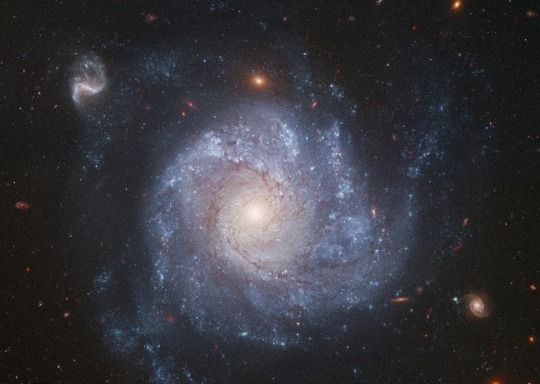
By analyzing the present rate of cosmic expansion, known as the Hubble constant, scientists can estimate the age of the universe and details of its fate, such as whether it will expand forever, collapse upon itself or rip apart completely.
Scientists use two primary strategies to measure the Hubble constant. One involves monitoring nearby objects whose properties researchers understand well, such as stellar explosions known as supernovas and pulsating stars called Cepheid variables, to estimate their distances.
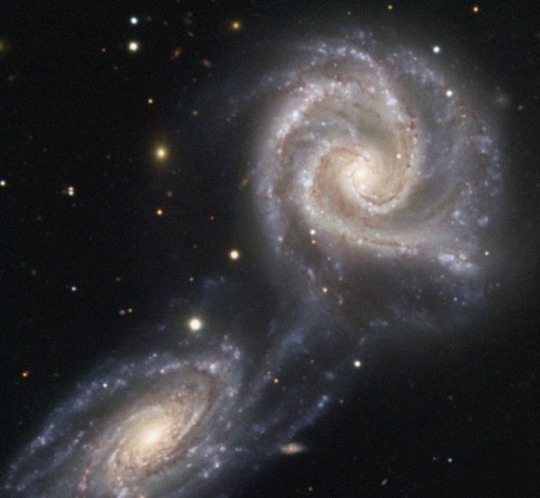
The other focuses on the cosmic microwave background (CMB), the leftover radiation from the Big Bang, examining how it has changed over time to estimate how quickly the cosmos has expanded.
However, this pair of methods has produced two different results for the value of the Hubble constant. Data from the CMB suggests that the universe is expanding at the rate of about 41.9 miles (67.5 kilometers) per second per megaparsec (a distance equivalent to 3.26 million light-years).
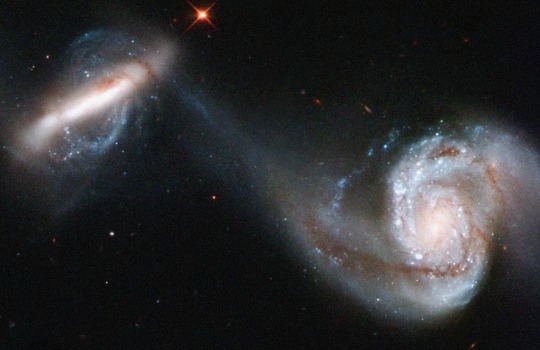
In contrast, data from supernovas and Cepheids in the nearby universe suggests a rate of about 46 miles (74 km) per second per megaparsec.
This inconsistency suggests that the standard cosmological model — scientists' current understanding of the universe's structure and history — might be wrong. Resolving this controversy, known as the Hubble constant conflict, could shed light on the evolution and fate of the cosmos.
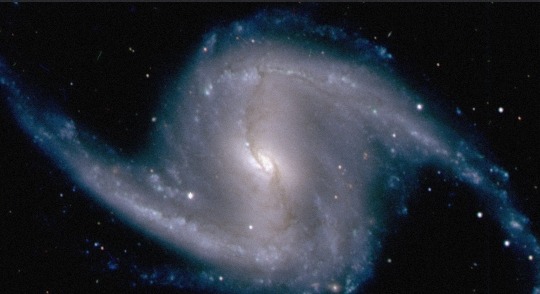
In the new study, an international research team explored another way to measure the Hubble constant. This approach depends on Einstein's model of gravity, in which mass distorts space-time, a bit like how a bowling ball might stretch a rubber sheet it was resting on. The greater the mass of an object, the more that space-time curves around the item, and so the stronger the object's gravitational pull is.
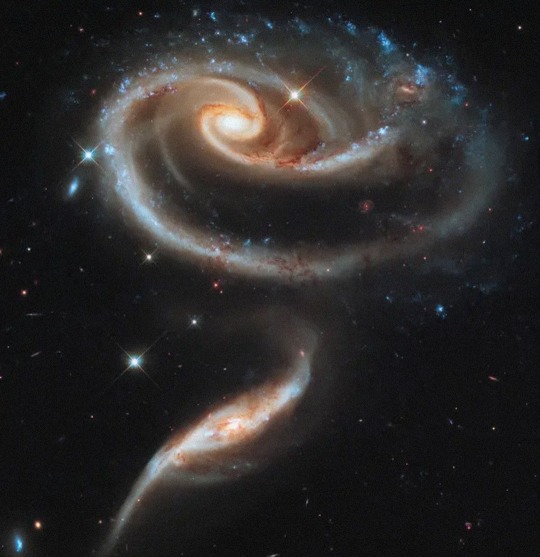
The way in which gravity behaves means that it can bend light like a lens would, so objects seen through powerful gravitational fields, such as those produced by massive clusters of galaxies, are magnified. Gravitational lensing was discovered a century ago, and today, astronomers often use these lenses to see features otherwise too distant and faint to detect with even the largest telescopes.
Originally published on www.space.com
COMING UP!!
(Saturday, February 17th, 2024)
"HOW MUCH LONGER WILL OUR SUN BURN??"
#astronomy#outer space#alternate universe#astrophysics#universe#spacecraft#white universe#space#parallel universe#astrophotography
46 notes
·
View notes
Text
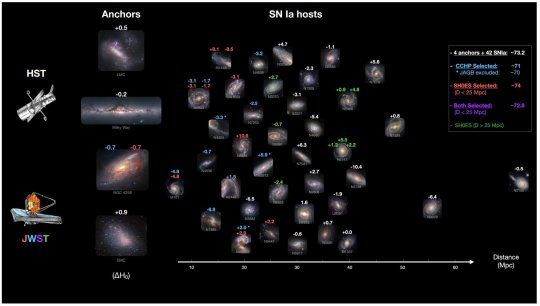
Webb telescope's largest study of universe expansion confirms challenge to cosmic theory
New observations from the James Webb Space Telescope suggest that a new feature in the universe—not a flaw in telescope measurements—may be behind the decade-long mystery of why the universe is expanding faster today than it did in its infancy billions of years ago.
The new data confirms Hubble Space Telescope measurements of distances between nearby stars and galaxies, offering a crucial cross-check to address the mismatch in measurements of the universe's mysterious expansion. Known as the Hubble tension, the discrepancy remains unexplained even by the best cosmology models.
"The discrepancy between the observed expansion rate of the universe and the predictions of the standard model suggests that our understanding of the universe may be incomplete. With two NASA flagship telescopes now confirming each other's findings, we must take this [Hubble tension] problem very seriously—it's a challenge but also an incredible opportunity to learn more about our universe," said Nobel laureate and lead author Adam Riess, a Bloomberg Distinguished Professor and Thomas J. Barber Professor of Physics and Astronomy at Johns Hopkins University.
Published in The Astrophysical Journal, the research builds on Riess' Nobel Prize–winning discovery that the universe's expansion is accelerating owing to a mysterious "dark energy" permeating vast stretches of space between stars and galaxies.
Riess' team used the largest sample of Webb data collected over its first two years in space to verify the Hubble telescope's measure of the expansion rate of the universe, a number known as the Hubble constant.
They used three different methods to measure distances to galaxies that hosted supernovae, focusing on distances previously gauged by the Hubble telescope and known to produce the most precise "local" measurements of this number.
Observations from both telescopes aligned closely, revealing that Hubble's measurements are accurate and ruling out an inaccuracy large enough to attribute the tension to an error by Hubble.
Still, the Hubble constant remains a puzzle because measurements based on telescope observations of the present universe produce higher values compared to projections made using the "standard model of cosmology," a widely accepted framework of how the universe works calibrated with data of cosmic microwave background, the faint radiation left over from the Big Bang.
While the standard model yields a Hubble constant of about 67–68 kilometers per second per megaparsec, measurements based on telescope observations regularly give a higher value of 70 to 76, with a mean of 73 km/s/Mpc.
This mismatch has perplexed cosmologists for over a decade because a 5–6 km/s/Mpc difference is too large to be explained simply by flaws in measurement or observational techniques. (Megaparsecs are huge distances. Each megaparsec is 3.26 million light-years, as a parsec is 3.26 light-years, and a light-year is the distance light travels in one year: 9.4 trillion kilometers, or 5.8 trillion miles.)
Since Webb's new data rules out significant biases in Hubble's measurements, the Hubble tension may stem from unknown factors or gaps in cosmologists' understanding of physics yet to be discovered, Riess' team reports.
"The Webb data is like looking at the universe in high definition for the first time and really improves the signal-to-noise of the measurements," said Siyang Li, a graduate student working at Johns Hopkins University on the study.
The new study covered roughly a third of Hubble's full galaxy sample, using the known distance to a galaxy called NGC 4258 as a reference point. Despite the smaller dataset, the team achieved impressive precision, showing differences between measurements of under 2%—far smaller than the approximately 8–9% size of the Hubble tension discrepancy.
In addition to their analysis of pulsating stars called Cepheid variables, the gold standard for measuring cosmic distances, the team cross-checked measurements based on carbon-rich stars and the brightest red giants across the same galaxies.
All galaxies observed by Webb together with their supernovae yielded a Hubble constant of 72.6 km/s/Mpc, nearly identical to the value of 72.8 km/s/Mpc found by Hubble for the very same galaxies.
The study included samples of Webb data from two groups that work independently to refine the Hubble constant, one from Riess' SH0ES team (Supernova, H0, for the Equation of State of Dark Energy) and one from the Carnegie-Chicago Hubble Program, as well as from other teams.
The combined measurements make for the most precise determination yet about the accuracy of the distances measured using the Hubble Telescope Cepheid stars, which are fundamental for determining the Hubble constant.
Although the Hubble constant does not have a practical effect on the solar system, Earth, or daily life, it reveals the evolution of the universe at extremely large scales, with vast areas of space itself stretching and pushing distant galaxies away from one another like raisins in rising dough.
It is a key value scientists use to map the structure of the universe, deepen their understanding of its state 13–14 billion years after the Big Bang, and calculate other fundamental aspects of the cosmos.
Resolving the Hubble tension could reveal new insights into more discrepancies with the standard cosmological model that have come to light in recent years, said Marc Kamionkowski, a Johns Hopkins cosmologist who helped calculate the Hubble constant and has recently helped develop a possible new explanation for the tension.
The standard model explains the evolution of galaxies, cosmic microwave background from the Big Bang, the abundances of chemical elements in the universe, and many other key observations based on the known laws of physics. However, it does not fully explain the nature of dark matter and dark energy, mysterious components of the universe estimated to be responsible for 96% of its makeup and accelerated expansion.
"One possible explanation for the Hubble tension would be if there was something missing in our understanding of the early universe, such as a new component of matter—early dark energy—that gave the universe an unexpected kick after the Big Bang," said Kamionkowski, who was not involved in the new study.
"And there are other ideas, like funny dark matter properties, exotic particles, changing electron mass, or primordial magnetic fields that may do the trick. Theorists have license to get pretty creative."
IMAGE: Anchors and SN Ia hosts selected to cross-check HST and JWST distances from the full HST sample of 4 anchors and 42 SNe Ia. Credit: Adam G. Riess et al
9 notes
·
View notes
Photo
The more important the star in navigation, the more names it gets.
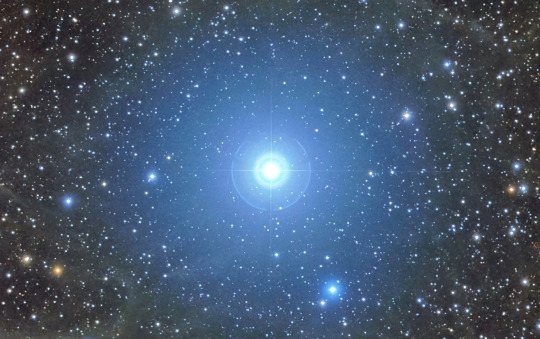
Polaris, Star of Many Names
3K notes
·
View notes
Text
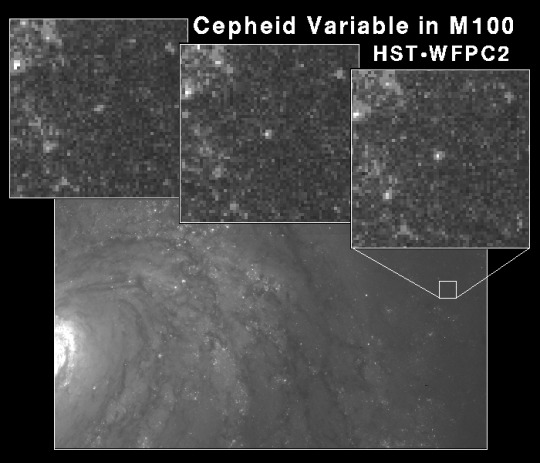
The Cepheids of M100 - January 10th, 1996.
"Can this blinking star tell us how fast the Universe is expanding? Many astronomers also believe it may also tell us the age of the Universe! The photographed "Cepheid variable" star in M100 brightens and dims over the course of days as its atmosphere expands and contracts. A longer blinking cycle means an intrinsically brighter star. Cepheid variable stars are therefore used as distance indicators. By noting exactly how long the blinking period is and exactly how bright the star appears to be, one can tell the distance to the star and hence the star's parent galaxy. This distance can then be used to match-up easily measured recessional velocity ("redshift") with distance. Once the "Hubble relation" was determined for M100, it can then apply to all galaxies - and hence can tell us how fast the Universe is expanding."
32 notes
·
View notes
Text
Discovery Alert! In a new discovery released on September 12, 2023, James Webb Telescope Validates Hubble's Findings on Universe Expansion Rate. Read full article here
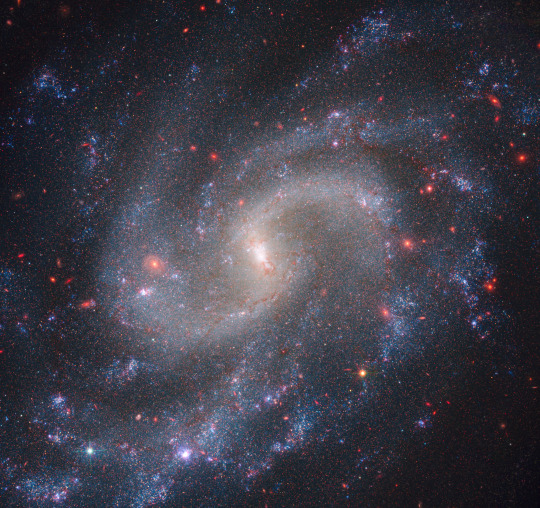
Prepare to be awestruck because NASA's James Webb Space Telescope has just dropped some mind-blowing revelations about the universe's expansion rate, and it's a cosmic rollercoaster of discoveries! 🌠
🔭 Imagine a telescope that can peer back in time and unveil the secrets of our universe's evolution. That's exactly what the Webb Telescope, NASA's latest star player, has been up to!
🌟 The Hubble Constant Mystery: One of the cosmos' biggest head-scratchers has been the Hubble Tension – a cosmic conundrum stemming from a puzzling mismatch between the measured expansion rate (Hubble constant) and its prediction from the Big Bang. 🌌
🌠 Cepheid Variables & Type Ia Supernovae: Webb's got some stellar assistants – Cepheid variables and Type Ia supernovae. These cosmic gems help astronomers measure vast cosmic distances and, by extension, the Hubble constant. 💫
🌈 Infrared Vision Superpowers: What sets Webb apart is its remarkable near-infrared vision. Unlike visible light, infrared light pierces through cosmic dust, offering clearer views of these celestial distance markers. 🌌
🪐 Results So Far: Webb's observations have confirmed the precision of the Hubble Space Telescope's earlier measurements while significantly reducing measurement noise. It's like seeing the universe's secrets with a magnifying glass! 🔍🌠
🔮 The Hubble Tension Deepens: But here's the kicker: the Hubble Tension persists! The universe seems to be expanding faster than we predicted. Could this be a hint of exotic dark energy, dark matter, or something completely unexpected? 🌌✨
🚀 The Cosmic Adventure Continues: With Webb confirming Hubble's measurements, the quest to decipher the universe's mysteries deepens. What's next? More observations, more data, and more cosmic riddles to solve! 🌌🔍
Join us as we journey into the heart of the cosmos, armed with the Webb Telescope's revelations and an insatiable curiosity for the universe's grand secrets. Stay tuned for more cosmic updates! 🌠🛰️
58 notes
·
View notes